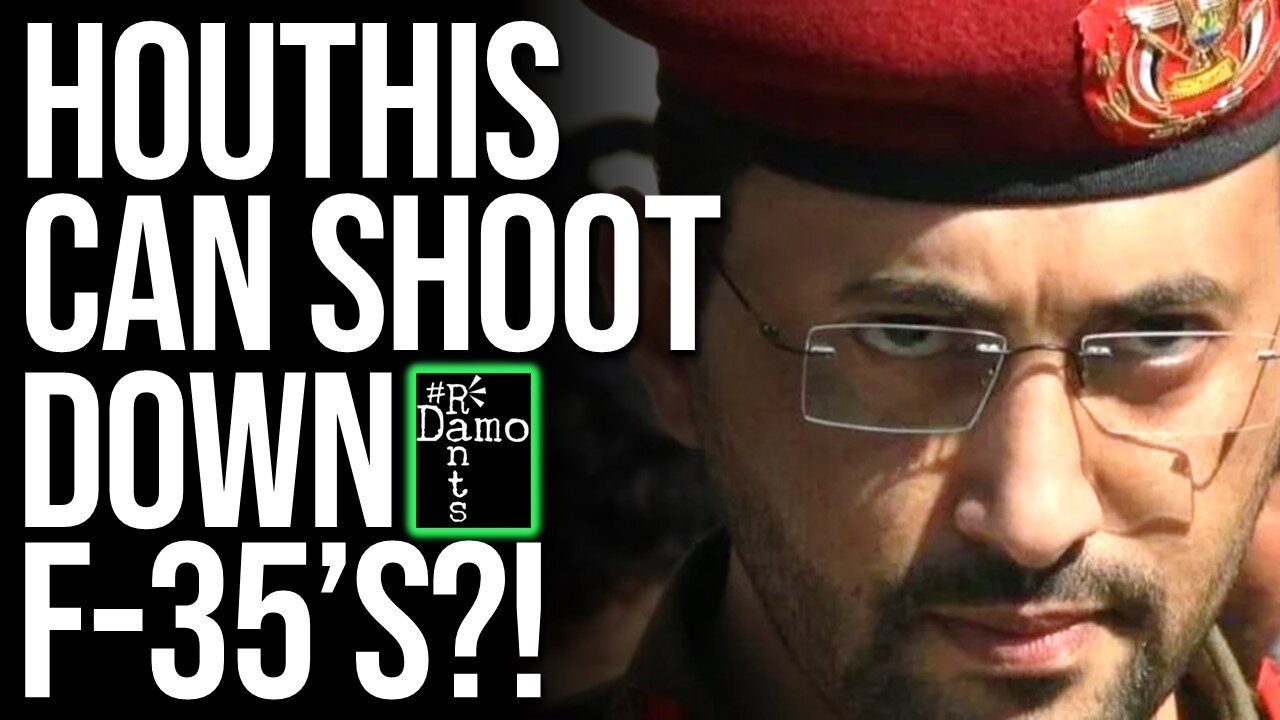Premium Only Content

Have The Houthis Just Rendered The F-35 Jet Obsolete?
Right, so its been just over a week since Trump agreed to stop striking the Houthis of Yemen and leave Israel to their devices, and true to form the Houthis have stopped striking US ships and focussed their attention on Israel, once more going after Ben Gurion airport with hypersonic missile strikes, shutting down Israel’s airspace, convincing many airlines who had suspended operations to Tel Aviv to very much continue to do so at that. But the Houthi shut down of airspace might have been more effective than even the Houthis might have thought because where they might have planned to shut down commercial flights, did they ever think they might shut down airspace to military flights too?
In reports that cover more details in connection with this that are now only just emerging, it seems that one of the biggest reasons Trump might have withdrawn when he did, during the commencement of Operation Rough Rider, might have been because where reports of US drones being brought down were widespread, less well documented were the number of near misses of F-16 and F-35 jets who were nearly shot down by the Houthis too. The F-35 is the top of the range when it comes to US aerial dominance and if the Houthis, with their far less sophisticated tech, can bring one down, as they very nearly had, and it was likely only a matter of time until they did, US claims to be the dominant air force on the planet would have been laughed at. So did Trump retreat to save his military their blushes, because this jet isn’t all that after all?
Right, so can you imagine the headlines if the Houthis had shot down an F-35? Well apparently they very nearly did and on more than one occasion.
When US President and professional tangerine impersonator Donald Trump’s administration entered into a ceasefire with the Houthis after months of relentless bombing and military pressure in support of Israel, in support of the genocide they are still carrying out even now, it marked a pivotal moment, panicking Israel and coming as something of a surprise, despite news of divisions between Trump and Netanyahu, and despite Trump’s unpredictability, nobody really saw it coming. The United States, having spent vast resources and committed considerable air power under Operation Rough Rider, a $1billion waste of US public money, they failed to gain air superiority over the Houthi-held territories. Now its easy to think in terms of the drones that have been shot down to explain away such a claim, but the news coming out now is that this was less about cost and embarrassment, than abject alarm when Houthi missiles nearly downed a US F-35 fighter jet over the Red Sea—the supposed pinnacle of American air superiority.
This near-miss, which was reportedly achieved with a mobile surface-to-air missile, SAM system that the Houthis deploy, of comparatively much lower technological sophistication, sent shockwaves through the military as a result. The notion that a group still regarded as a bunch of backward rebels could compromise a $100+ million fifth-generation fighter jet wasn't just a military embarrassment; it caused absolute panic. With the USS Harry S. Truman now leaving the Red Sea and no replacement being deployed, the reasoning behind this withdrawal is unmistakable in that the US presence have been forced into a humiliating retreat. That despite claims of withdrawing due to agreement with the Houthis because they’d taken enough of a pasting from the US and this was altruism on Trump’s part, this is being revealed to be more and more due to battlefield failures and the fear of further losses, along with massive reputational damage.
As the US quietly disengages and leaves though, the Houthis have redirected their focus squarely on Israel.
Since the US ceasefire, the Houthis have struck Israeli territory multiple times, with particular focus on strategic targets such as Ben Gurion Airport. In recent days alone, three hypersonic missile attacks targeted the airport, temporarily closing Israel’s airspace and causing global airlines to continue to suspend flights to Tel Aviv.
The Israeli military's response has been both brutal and telling. In retaliation, Israeli jets have bombed critical Yemeni infrastructure, including the ports of Hudaydah and Salif, with reports of civilian casualties and significant damage to economic facilities. They don’t know where the Houthis are, so they just strike civilian targets indiscriminately instead. Israeli officials, allegedly called for the evacuation of these Yemeni ports—but as it turned out, only after they were bombed.
And amid all the Israeli failure to contain of challenge the Houthis, they’re back to making threats they’ve shown no sign of ever having been able to deliver on, the insane Israeli defence minister Israel Katz now threatening to assassinate the Ansar Allah leader Abdul Malik al-Houthi. A post on The Cradle Telegram channel reading:
‘Shortly after Israel launched targeted airstrikes on Yemeni ports, Israeli Defense Minister Israel Katz threatened to assassinate the Yemeni Ansar Allah leader, Abdul Malik Al-Houthi, if Yemen continues to fire missiles at Israel.
In a posted statement, Israeli war criminal Netanyahu described the attacks on the Yemeni ports as “just the beginning,” adding, “We will not stand idly by and allow the Houthis to harm us. We will strike them with greater force, including at their leadership and all the infrastructure.”’
Except of course if you knew where the Houthis and their leaders and their assets were, you’d have done it already.
Katz’s words, these actions they have not and will not deter the Houthis. But perhaps the most troubling implication for Israel in mongst their threats and their rhetoric and by extension Western military powers is the vulnerability of their air assets, coming back to those F-35s. The US spent years insisting that the F-35 was an untouchable force on the battlefield—capable of penetrating any air defence system, invulnerable to low-tech foes, a Western collaborative project as building these jets has become and the export of parts from here in the UK has been a bone of contention for a long time and especially again now, that Starmer’s labour is in court over more arms licences having been issued, instead of ending more of them especially when it comes to F-35s. That myth of invincibility is now unravelling. It has now been confirmed that multiple F-35 and F-16 aircraft narrowly avoided destruction during missions over Yemen and the Red Sea, as part of Operation Rough Rider, thanks to Houthi missile fire. These encounters raise urgent questions not only about U.S. military planning, but about the survivability of the aircraft in high-threat environments and this is a point raised by defence and national security writer Harrison Kass in an article he wrote for The National Interest in response to these near misses, an excerpt reading:
‘According to new reporting from the New York Times, a Houthi surface-to-air (SAM) missile barely missed an American F-35 fifth-generation fighter, the crown jewel of the U.S. fighter inventory. The F-35, participating in Operation Rough Rider against the Houthis, was forced to take evasive action to avoid the missile.
The incident raises questions about the survivability of one of America’s most advanced fighters, and raises concerns over how effective the relatively unsophisticated Houthi air defense system has been at hampering U.S. action.
“Several American F-16s and an F-35 fighter jet were nearly struck by Houthi air defenses, making real the possibility of American casualties,” military analyst Gregory Brew posted on X, adding that the Houthis were successful in shooting down “seven American MQ-9 drones (around $30 million each), hampering Central Command’s ability to track and strike the militant group.”
So, just how vulnerable are American fighters to the Houthis’s air defense system?
The Houthi air defense system is rudimentary. However, it is highly mobile—meaning the defense systems can pop up just about anywhere, making them unpredictable and hard to plan around. Moreover, the simplistic nature of the systems also helps them to avoid earlier detection by America’s advanced equipment. “Many of the [SAMs] are also improvised, leveraging non-traditional passive infrared sensors and jury-rigged air-to-air missiles that provide little to no early warning of a threat, let alone an incoming attack,”’
Such have been the technological advancements by the West, that the old Cold War era tech the Houthis mostly have has actually become more effective against it.
With Israel also of course fielding F-35 jets in its air force, the implications are pretty clear and Western powers may well remain nervous especially if, as is now being surmised, Trump pulled out of the Red Sea, to save the F-35s blushes. As long as Israel continues to target Yemen with them though, it may soon suffer the fate that the US narrowly avoided and the reputational damage to these craft will still be done. The Houthis have shown they are improving their missile tracking and targeting systems, and it increasingly looks like it is only a matter of time before an F-35 is lost to fighting the Houthis. Such an event would devastate the credibility of Western military supremacy and shake global confidence in the US-led defence industrial complex. Few people wanting peace and wanting Israel stopped will shed a tear for that given the complicity they’ve shown though will they?
The resurgence of the Houthi-Israeli conflict without US support any longer is teaching some a hard lesson of how conventional military thinking can underestimate determined, adaptive adversaries. The Houthis ability to improvise and strike back is not merely a testament to a homegrown capacity for innovation and tactical evolution, that has happened everywhere from underground bunkers to backyard sheds.
But it isn’t just the US and their capabilities that have been undermined here and this is why the Houthis current campaign against Israel is not just a military strategy, but a political one as well. By blockading Israeli shipping routes, targeting critical infrastructure, and confronting Israeli airspace, the Houthis are undermining the myth of Israeli invulnerability too and that they cannot or should not be touched, but they are doing so at a moment when much of the world is watching with horror as Gaza continues to suffer under one of the most intense bombing campaigns in modern history, the global opinion of Israel having shifted and winning the Houthis much by way of plaudits amongst ordinary people the world over, even if foreign governments backed by Zionist Lobbyists or agendas are increasingly glum about it.
Therefore all in all, the Houthis actions are a sign of a deeper global shift. The US withdrawal from Yemen and the Red Sea is not just a tactical retreat; it is a sign of the fading established order. A movement once dismissed as rag-tag insurgents has not only resisted the most powerful military alliance in the world but has turned its focus to Israel—a state that has for decades enjoyed unchecked military supremacy in the region and Western support and the US has walked away and left them to it. Tell me they didn’t win then?
The Houthi strikes on Ben Gurion Airport, the bold use of hypersonic missiles, and the growing precision of their mobile SAM operations, creating naval blockades of shipping without any navy of their own, time after time they are rewriting the rules of engagement. These developments must serve as a wake-up call—not only for military strategists but for all those who believe in justice, sovereignty, and the right of people to resist occupation and aggression.
Israel’s actions in Yemen—much like its ongoing war on Gaza—are not justifiable by any standard of international law or moral reasoning. As more voices in Yemen rise in protest and more missiles find their mark, the cost of this aggression for Israel will only increase. And perhaps then, the world will be forced to confront an uncomfortable truth: that power, no matter how technologically advanced, or how hard they might lobby and propagandise are not invincible in the face of determined resistance and more importantly than that, the truth.
On top of all of this, the Houthis have recently announced new tech to help them in their bid to enforce a blockade of Israel’s airspace aside from ongoing strikes on ben Gurion airport, and who would put it past them these days after all? Get all the details of that story in this video recommendation here as your suggested next watch.
Please do also hit like, share and subscribe if you haven’t done so already so as to ensure you don’t miss out on all new daily content as well as spreading the word and helping to support the channel at the same time which is very much appreciated, holding power to account for ordinary working class people and I will hopefully catch you on the next vid. Cheers folks
-
 40:24
40:24
The Connect: With Johnny Mitchell
1 day ago $1.51 earnedInside The WORST Drug-Infested Slums Of Medellin, Colombia
8.36K4 -
 1:43:56
1:43:56
Tundra Tactical
5 hours ago $3.23 earned🛑LIVE NOW!! FBI Gets Caught LYING About Good Guys With Guns For 10 YEARS!!!!
22.9K1 -

BlackDiamondGunsandGear
2 days agoAFTER HOURS ARMORY / Antifa / Lies/ Prison time
11.8K1 -

DLDAfterDark
5 hours ago $1.35 earnedThe After Hours Armory! Tonight is The Chat's Chat! God, Guns, and Gear!
15.9K1 -
 3:32:18
3:32:18
Mally_Mouse
8 hours ago🌶️ 🥵Spicy BITE Saturday!! 🥵🌶️- Let's Play: Phasmophobia
33.9K4 -
 1:13:19
1:13:19
iCkEdMeL
4 hours ago $7.34 earnedChaos Explodes in Chicago & Portland | Feds Clash with Protesters!
26.7K7 -
 21:54
21:54
Exploring With Nug
1 day ago $7.53 earnedScuba Diving Missing Person Search Leads to Discovery of Classic Cars!
49.5K8 -
 LIVE
LIVE
Phyxicx
8 hours agoStar Wars: Movie Battles II Community Event hosted by ReaperAF95 - 10/4/2025
199 watching -
 1:19:51
1:19:51
World2Briggs
7 hours ago $2.14 earnedThe US This Week
29.2K3 -
 2:31:13
2:31:13
Joker Effect
4 hours ago"MAKE STREAMING GREAT AGAIN" - Brands Step Up Finally. Birth of Rumble Community. Taking Leadership
16.6K1
